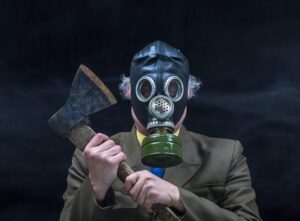
Countries around the globe are on high alert as terrorists continue their attempt to harm or kill innocents.
Ronald Noble, founder of RKN Global emphasizes the importance of being prepared for the threats that our society faces, including a terrorist attack using chemical weapons. Chemical weapons can be defined as ‘[p]oisonous vapours, aerosols, liquids and solids that have toxic effects on people, animals or plants.’1
Who uses chemical weapons?
Terrorists and other organizations use chemical weapons to injure or kill innocent civilians and those whom they wish to harm. Chemical weapons have the potential to injure a large number of people, often due to the ease of distributing the agent. Many chemical weapons are airborne gases, and therefore can spread quickly and widely.
Is the threat real?
Chemical weapons could be used to ‘[h]arm as many people as possible, and terrorize as many people as possible’.2 In the first half of 2016, it was reported that there were 161 chemical attacks in Syria. These attacks alone resulted in the deaths of nearly 1,500 people.3 This figure is alarming, and suggests the fatal potency of these agents and the readiness of some to use them.
How to prepare for an attack
The phrase “an ounce of prevention is worth a pound of cure” is worth keeping in mind when we consider how to prepare for a chemical weapon attack.
Preparation for a chemical weapons attack should include:
- Creating an emergency supply kit which contains three days’ worth of food, water, and medication for each person. Flashlights, a battery or solar powered radio, spare batteries, warm and waterproof clothing, duct tape, scissors and a first aid kit should also be included in the kit.
- Purchasing plastic sheets and cutting them to fit around every door and window in the home. Plastic sheets can be sealed with duct tape, and could help to prevent poisonous vapors and other substances from entering the home.
- Planning how and where everyone will escape to. Practicing the escape plan at least once every six months, so everyone knows where they need to be and what they need to do in the event of an attack.
- Finding a room to shelter in; the room should “preferably [be] one without windows and on the highest level.”1
- Setting in place plans so that if family members are apart when an attack occurs, they know where to meet, how to contact each other, and how to stay safe.
- Inquiring about emergency plans at places of work, daycare centers, and schools.
What to do during an attack
When a chemical attack occurs, those who have not immediately been affected may only have moments to find shelter. The following actions should be taken so as to remain as safe as possible:
- Try to determine where the attack is coming from, if it is possible and safe enough to do so.
- Leave the area as quickly as possible.
- If the attack has occurred inside a building, try to move as far away from it as possible, without passing through any area where signs of an attack are visible (Such as casualties lying on the ground, or damage to the building).
If you are at home when an attack occurs:
- Close all windows and doors, and turn off any vents, air conditioners, furnaces, and fans.
- Go straight to your safe room.
- Seal the room with plastic sheeting and duct tape.
- Turn your radio on, and listen for instructions from authorities.1
RKN Global’s founder, Ronald K. Noble, stresses the importance of communicating with the authorities during an emergency like a chemical weapons attack.
Please note you may have to stay where you are for days. Emergency agencies may take a long time to reach anyone involved in the attack. Please do not move from the place of safety unless it is clearly safe to do so.
How to act after a chemical weapon attack
Ideally, decontamination would occur within the first few minutes of an attack. However, this may not always be possible, resulting in a rising number of casualties.
Decontamination can be carried out by those who may have become the victim of a chemical weapon attack. The recommended method includes:
- Removing all clothing, jewelry, and any other object that has been in contact with the body.
- Clothes should be cut off if they are ordinarily removed over the head.
- Clothes than have been contaminated should be placed in a sealed plastic bag.
- Hands should be washed with soap and water.
- Contact lenses and glasses should be removed. Contact lenses should be placed in a plastic sealed bag, glasses should be placed in bleach before being rinsed and dried.1
- Eyes should be washed with water.
- Any area of the body that may have become contaminated should be washed gently using soap and water. Do not scrape the areas that may be contaminated, instead blot them.
- Change into clothes that have been kept in a closet or a drawer, as they are less likely to be contaminated.
- When it is safe to do so, those affected or who suspect they may be affected should make their way to the nearest medical facility.
If there is uncertainty about an attack
If there is some uncertainty as to whether an attack has occurred, the best thing to do is to reach a place of safety. Follow the emergency plans and ensure the emergency supply kit is to hand. Follow all the steps set out in the emergency plan and contact the authorities, or listen to the emergency channels on the radio to determine if there is a threat. Prevention is always better than cure; if no attack has occurred, use the experience to think about how to make the evacuation plan better.





